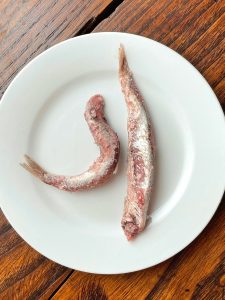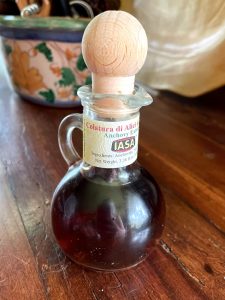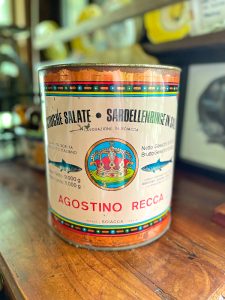At Restaurant du Village, we served a dish called Pasta à la Provençal. (It was our version of the Italian harlot’s classic, Pasta Puttanesca.) We made large vats of the sauce to serve over spaghetti. My favorite step was smelling the anchovies melting into the garlic in that giant pot. I could not resist dragging a slice of bread through that fragrant paste. Anchovies are the character actors that make a dish a hit.
The anchovy-averse might want to stop reading right here.
I feel for you. I’ve eaten my share of foul-smelling salted fish, especially on top of pizza. (As a kid a slice of my dad’s anchovy pie would accidentally contaminate mine. Blech.) A food broker once told me that the better chain pizza restaurants buy small cans of anchovies. They open a fresh can every time someone orders an anchovy pizza. Just to ensure freshness. Those chains never opened in my hometown.
Whether in Caesar salad dressing, on top of pizza or on hard boiled eggs, anchovies make so many dishes sing. On pissaladière, their arch saltiness is a bright contrast to sweet, simmered onions. In a garlicky sauce with chilled cooked and raw vegetables, anchovies add a rich meatiness that turns legumes into a meal.
Because anchovies have savory umami in abundance, they give rich undertones to fish and tomato sauces. We stud lamb with minced anchovies, rosemary and garlic before slow roasting. Roasted red peppers plated with anchovies was a Swiss hotel school staple that deserves a second act. I cannot imagine a hard-boiled egg in salad Niçoise without an accompanying anchovy.
But all this deliciousness requires some expertise.
Because they come in so many forms, there must be one to charm (most) everyone.
Here’s my take on anchovies, how to buy, store and use them.
Forms of Anchovies
SeafoodSource says that more than 20 fish species constitute the anchovy family. They are found in warm waters around the globe where they swim in dense schools. (I’m pretty sure we’ve caught them in Long Island Sound where we use seines to catch and fry tiny fish called whitebait. Their large eyes and bright silver skin is unmistakable.)
Salted Whole Anchovies
These are closest to fish swimming in the sea with a plump meatiness you won’t find in anchovy fillets. The tiny fish are packed in layers with salt in jars or tins.
To use them, remove a fish or two and rinse them under cold running water. Soak the small fish in icy water for 10 – 15 minutes until pliable. You peel apart the two fillets by running your thumb along the belly. I’ve made a separate post with images on how to prepare whole salted anchovies here.
Whole salted anchovies work well in any recipe that calls for canned anchovy fillets.
Canned Anchovies
These are boned and skinned fillets of the fish. They are prepared in several steps. First the gutted fish are salted then packed in barrels by the thousands where they develop their color and rich umami flavor. (The curing takes from 3 months to a year; shorter times produce meatier fillets.) Then a work crew painstakingly fillets and hand packs them into glass jars or tins. Finally they are covered with olive oil then heat processed to render them shelf stable.
Canned anchovies win for ease-of-use. Open the can or jar to reveal neat layers of deep rose-colored fillets. Sometimes the fillets are rolled around a few capers. They look like tiny evil eye charms. Use these to garnish hard boiled eggs or halved tomatoes. Or on Schnitzel à la Holstein (Fried breaded veal cutlet garnished with a fried egg and rolled anchovy, talk about a hotel school classic.)
White Anchovies
These are lightly salted fillets pickled in an oil and vinegar solution. Unlike salted whole or canned anchovies, their light fresh taste is closer to pickled herring. Because they are a little fresher tasting, you can be more adventuresome with them, especially in starring roles. Unadorned with a whisp of olive oil for example.
Anchovy Paste
Anchovy paste comes in tubes. It is made from preserved anchovy fillets ground into a smooth spread. Squeeze a little into salad dressing for that instant umami kick. Most of the time anchovy paste lacks the pronounced flavor of quality anchovies. But you don’t know until you open the tube so I only use it in cold preparations like mayonnaise or salad dressing. Heating will bring out any off flavors.
Coloratura
Coloratura is a magical condiment, the liquid essence of cured anchovies. It is made from the liquid that seeps out of anchovies during salt curing. (A descendant of the famed garum, a condiment from ancient Rome and a cousin of Asian fish sauces such as Vietnamese nuoc mam too. A side note, coloratura refers to some extraordinary sopranos.)
How to Select + Store Anchovies
Inferior quality and stale anchovies are responsible for many cook’s aversion to them. Touring an anchovy plant in Morocco, I learned how to recognize those that taste the best.
- Look for anchovies packed in glass jars. Choose those that have a bright color with reddish tint. A bright rich color indicates freshness.
- Store salted anchovies and unopened jars (or cans) of anchovies in the refrigerator. That’s what Europeans do. In fact, European groceries keep anchovies under refrigeration.
- Once you open a can or jar of anchovies, the fish deteriorate rapidly. After opening a can of anchovies, cover any exposed fillets with oil. Then plan to use them up that afternoon or within a couple of days. How, you ask? On a slice of buttered toast with a squeeze of lemon works. (More ideas below.)
- Under refrigeration, opened containers of whole salted anchovies keep longer than other forms. Make sure to add salt as needed to keep the fish covered.
- Use up an opened tube of anchovy paste within a month. Because it’s impossible to gauge the quality of the paste, use it to flavor mayonnaise or salad dressing for example. When heated, stale anchovy paste gives off the odor of cat food.
Anchovy Brands
An oily fish, anchovies spoil quickly. Once caught, the fish must be cleaned and processed quickly. We cannot know how the freshly-caught fish were handled. By purchasing a recognized brand and paying a fair price I think you will find the best quality anchovies. (Resist the $3.49 can in the bargain bin.)
When money is no object, I buy Ortiz, the well-regarded Spanish brand of canned fish, only in jars. I’ve always had good luck buying fresh-looking anchovies packed in jars from Sclafani Foods and I never buy them in cans. (Repetition for emphasis.)
For salt packed anchovies, I like Nettuno Alici Salate, the brand in my fridge right now. Or those from Agostino Recca. (We turned one of their empty cans into a receptacle for wine corks.)
Importers of artisan foods from Europe such as Gustiamo (Italy) and Donostia (Spain) among others will offer more brands than I can count. I’m always tempted to try what they offer.
How to Use Anchovies
Anchovies have distinct personalities. And roles that bring out their best characteristics.
If you have read this far, you probably have a dozen ways to use anchovies. (Or you are still anchovy curious.) Here are a few of mine:
- Salad dressing – Caesar of course but also in a vinaigrette with lots of mustard to use on meat and strong fish like bluefish or mackerel. Brush some of this strong vinaigrette on the fish before and after cooking.
- Seasoning butter – Mash a few anchovy fillets together with a minced clove of garlic and lots of black pepper. Blend this into a stick (4 ounces) softened unsalted butter. This is great on grilled beef, lamb and boiled baby potatoes.
- Anchovy garlic drizzle – Anchovy fillets melted in olive oil with garlic and red pepper flakes – this savory drizzle packs a punch. Use it over cooked cauliflower, broccoli or bitter greens. Sprinkle the anchovy-oil-coated-vegetables with breadcrumbs then bake for added crunch
- Use the oil the anchovies come packaged in for salad dressings or steamed potatoes. Even if it is an industrial grade vegetable oil, the anchovies will have imparted some flavor to the oil.
- Layer canned anchovies between layers of puff pastry for a simple yet elegant snack or appetizer before an important feast.
- White anchovies are the main attraction. Lay them out on a small plate dressed with the best olive oil and a sprinkling of chopped parsley. Try them on toasted bread smeared with ripe tomato – the Spanish snack called pan con tomate. On top of a Caesar Salad too.
- Bread and deep fry salted whole anchovies that you have rinsed and cleaned.
[Pictured in the opening photo from top to bottom: whole salted anchovy, salted anchovy skin side then fillet side and canned anchovy fillet]
Side Trip
For some time, I’ve been collecting memories of our time running a restaurant. Short sketches mostly, sometimes accompanying a recipe. Here’s one from an essay called Clientes Fidèles
The kitchen crew and I always knew when “Wet Spaghetti” arrived. We’d catch a whiff of Paloma as she crossed the bar to enter the dining room. She once whispered to me, doe eyed as if staring down the barrel of a rifle, that she was a famous mobster’s niece. “You know who he is,” she said and I was as curious about her story as I was about her impeccable eye liner. (Who pinned gold bees to the shoulder of her jackets?) There was spaghetti à la provençal on the menu, a Frenchified pasta putanesca, that she liked. She instructed us to overcook the spaghetti and water down the sauce. “I like it wet,” she said, handing us her nickname that you bet your sweet life we did not forget.














